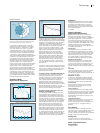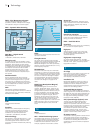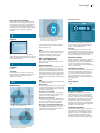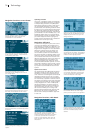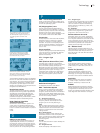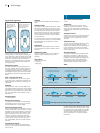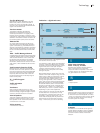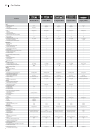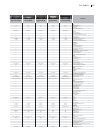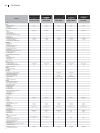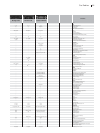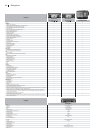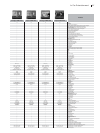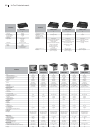
V
Video input: Composite
Video 1. OV p-p, 75 ohms
Describes the standard and the electrical
value of the signal to be connected.
Composite Video corresponds to the normal
TV signal, like the one emitted by DVD play-
ers, game stations or TV tuners.
W
Watts
➞ Output power
X
X-Bass
Psycho-acoustic boost of the low frequencies
at low volume. For almost all the car radios –
an exclusive feature for Blaupunkt car radios
– there is a menu which can be used to adjust
the effect of X-Bass feature to the existing
car-audio system in 6 stages.
Y
Y adapter
Distribution of a 2-channel stereo signal to
several different amplifiers using a Y-shaped
adapter to link the cables. Using Y adapters
can have an adverse effect on the fader
function.
TwinCeiver – digital twin tuner
Advanced development of the DigiCeiver with
two receivers in one car radio.
The TwinCeiver, which boasts two DSP-based
receivers, underscores Blaupunkt’s outstand-
ing position in perfect radio reception: crackl-
ing and noise due to multi-path reception
caused by apartment blocks in cities or
mountains in the countryside now virtually
belong to the past.
More distant stations, which were once well
outside of the usual reception range, are now
within reach as well: the TwinCeiver continu-
ously evaluates the digitised signals from
two antennas and combines them to create a
strong, clear signal that is free of interfe-
rence. This process, which was developed by
Blaupunkt engineers, is called DDA (Digital
Directional Antenna) and it mimics the reac-
tions of an extremely quick, automatic direc-
tional antenna – similar to TV “rabbit ears”
that deliver just “snow” or perfect reception
depending on just a small adjustment.
If the reception is currently so good that the
second antenna is not required, or if only
one antenna is connected, the radio can be
switched to “dynamic station lists”. This
means that the display will only show those
stations that are actually within reception
range – which saves you a lot of searching.
Tint (for NTSC only)
Regulates the colour and affects only the
NTSC mode, which is used in the USA. In
Europe, PAL is the corresponding signal, in
parts of France and Switzerland the SECAM
signal is the standard used.
Titanium tweeter
The titanium tweeters developed by
Blaupunkt are manufactured from an
extremely stiff titanium. The rigidity of the
titanium dome guarantees a seamless, lively
reproduction of the trebles and superb sound
definition. The titanium tweeter is used in all
the coaxial systems (ODx) of the OD series.
TMC-Out FM
Car radios with this output are able to for-
ward TMC data to any Blaupunkt navigation
system connected (e.g. TravelPilot DX-V) for
dynamic route guidance (separate connection
cable required). Prerequisite: the radio must
be set to an RDS station that transmits TMC
data.
TMC – Traffic Message Channel
A digital traffic information data channel with
constantly updated data on traffic conditions.
TMC receivers allow the user to select data
by entering such information as travelling
direction, area and road class. The latest
information, selected to suit the user’s indivi-
dual needs, is then available at the touch of a
button.
Total harmonic distortion (THD)
Measurement for distortion that indicates
the ratio of the sum of the powers of all the
harmonic frequencies above the fundamental
frequency to the power of the fundamental
frequency. Rule of thumb: lower values for
the same performance are usually a sign of
better sound quality.
TP – Traffic Program
➞ RDS
Traffic telematics
➞ Telematics
Travelstore
Search function that stores the six radio
stations with the strongest reception signals
sorted according to signal strength in a speci-
al memory bank at the touch of a button.
Triaxial speakers
Three-way speakers whereby the mid-range
tweeter is positioned in the centre of the
bass speaker on one axis and the tweeter is
on another axis on the side.
Triplex antenna
➞ Combination antenna
81
Technology
Antenna
Tuner 1
Imperfect
antenna signal
Signal
processing
Reception concept without the TwinCeiver
Tuner 1
AntennaAntenna
Imperfect
antenna signal
Optimal
antenna signal
Tuner 2
DDA
Signal
processing
Imperfect
antenna signal
Reception concept with the TwinCeiver





